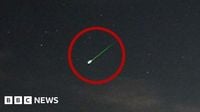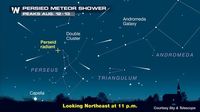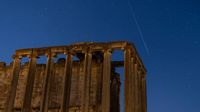Every summer, skywatchers across the Northern Hemisphere anticipate a celestial spectacle: the Perseid meteor shower. This year, the Perseids put on their dazzling show once again, peaking on the nights of August 12 and 13, 2025. Despite a bright moon and some challenging weather in certain regions, enthusiasts and casual observers alike flocked to observatories, parks, and high country escapes to catch a glimpse of what NASA calls "the best meteor shower of the year."
From Arizona’s historic Lowell Observatory, where astronomy has been a tradition for almost 130 years, to the high-altitude communities of Colorado and the foggy hills of Oakland, California, people gathered in droves to witness the annual light show. The Perseids, famous for their swift, bright meteors—often leaving long, colorful trails known as "wakes"—did not disappoint. According to the American Meteor Society, under ideal conditions, viewers can expect to see between 50 and 75 meteors per hour during the shower's peak. This year, though, the moon’s brilliance dimmed some of the spectacle, yet it did little to dampen the enthusiasm of those who made the trek to dark-sky sites.
In Flagstaff, Arizona, Lowell Observatory became a bustling hub for meteor-watchers. Nick Moskovitz, a longtime astronomer at the observatory, explained the science behind the show. "One of the things that makes us unique is we specialize in the science of the solar systems," Moskovitz told AZFamily. He added, "So, we study things in the solar system." His particular focus is on meteors, asteroids, and their impact on Earth—subjects that not only fuel scientific discovery but also spark public fascination. "I like that area of research because it’s very tangible. I can wrap my head around it. I can actually go out in the night sky and see these objects as they come in and show up as shooting stars," he said.
Moskovitz offered a simple yet vivid explanation of the Perseids: "A comet can leave behind a trail of bread crumbs and that trail of bread crumbs populates what we call the meteor stream. The earth is plowing through this stream of particles and those particles are hitting the atmosphere at high speed and burn up and vaporize and produce that flash of light." That flash, of course, is what we see as a shooting star.
Thousands of visitors flocked to Lowell Observatory during the peak nights, some arriving as early as 2 a.m.—the best time to observe the meteors, according to astronomers. The city of Flagstaff, recognized as the world’s first international dark sky city, provided an ideal setting with capped light pollution, allowing for clearer views of the night sky. For many, the experience was about more than just science; it was a chance to connect with the cosmos. As Moskovitz reflected, "Their lives and the earth in a broader context of the cosmos and how our understanding of the cosmos is very much tied to our existence here on planet earth."
Coloradoans, too, embraced the Perseids with open arms. At the Frisco Historic Park & Museum, a community event drew stargazers eager to participate in the cosmic celebration. Mark Laurin, affectionately known as "AstroMark" in Summit County, spoke to CBS Colorado about the event’s impact. "You're going to wake up in a better mood tomorrow," Laurin said, highlighting the restorative power of simply looking up. He noted the contagious curiosity that the event sparked: "All ages were engaged, curious and asking questions. Give me five minutes; it's going to lead to ten minutes. Ten minutes is going to lead to 30 minutes. Thirty minutes and I've got you hooked."
Many Coloradans sought out the high country, far from city lights, to maximize their viewing experience. And while the meteor shower is best seen now, Laurin assured attendees that the Perseids would continue to streak across the sky until the end of August. "The best chance to catch it is right now," he said, but encouraged everyone to keep watching through the month.
Meanwhile, on the West Coast, the Chabot Space and Science Center in Oakland hosted a star party on the peak night. Despite foggy conditions, dozens of visitors lined up to peer through the center’s historic 1883 telescope, donated by founder Anthony Chabot. Gerald McKeegan, a representative of the center, explained to KRON4 that what many call shooting stars are actually fragments of a comet entering our atmosphere. While telescopes are excellent for viewing planets, McKeegan and other experts recommend watching meteor showers with the naked eye for the best experience. The Chabot telescope, open to the public weekly, continues to inspire new generations of skywatchers nearly 150 years after it was first built.
Of course, not everyone enjoyed perfect conditions this year. Robert Lunsford, newsletter editor and fireball report coordinator for the American Meteor Society, told USA TODAY that the bright moon in 2025 meant the Perseids’ peak would fall short of ideal viewing. Even so, photographers and enthusiasts across the globe managed to capture stunning images of the meteor shower, sharing them widely on social media and news outlets. The Perseids are renowned for producing especially bright meteors—often called fireballs—that can light up the night sky with dramatic flair.
For those who missed the peak, there’s good news: the Perseid meteor shower began on July 17 and will remain visible until August 23. While the frequency of meteors diminishes after the peak, patient observers can still spot the occasional shooting star, especially under dark skies and away from city lights. As NASA reminds us, the Perseids are a highlight of the astronomical calendar, drawing both seasoned stargazers and first-timers to look up and marvel at the universe.
Ultimately, the Perseid meteor shower is more than just a scientific event; it’s a communal experience that bridges generations and inspires wonder. Whether gathered at historic observatories, hiking into the high country, or simply lying on a backyard lawn, people across the country and around the world found themselves united by the simple act of looking skyward. As the Perseids continue their annual journey, they remind us of our place in the cosmos—and the enduring allure of the night sky.






